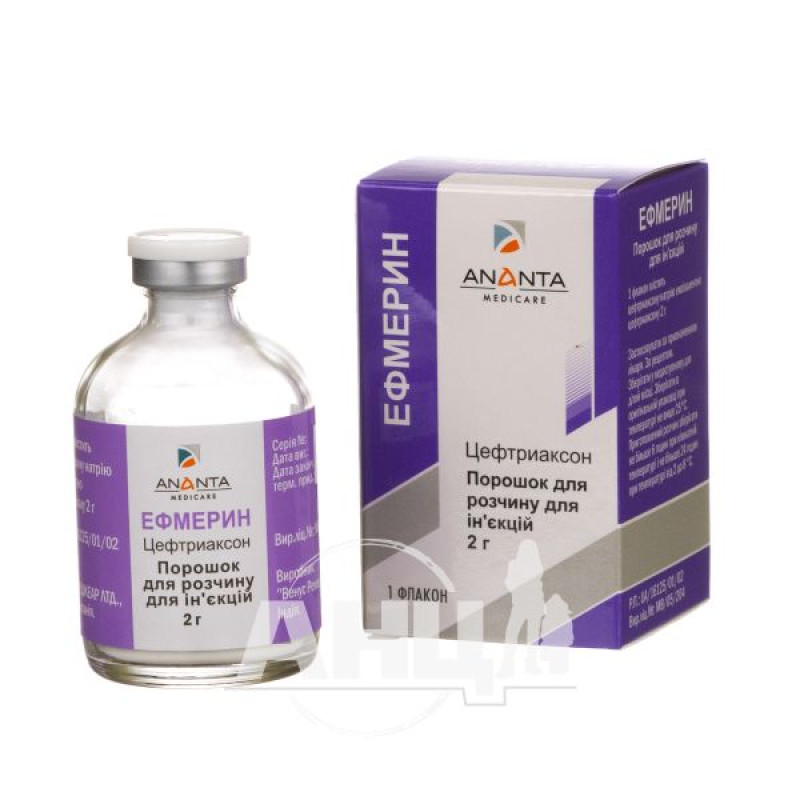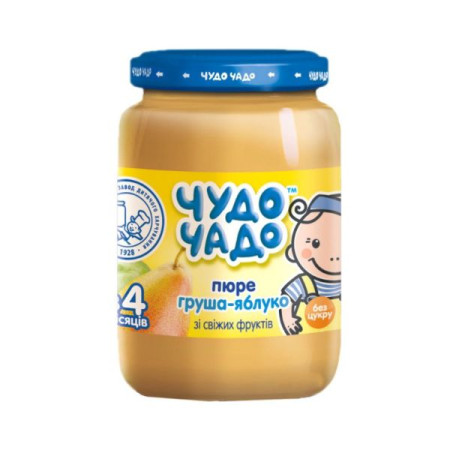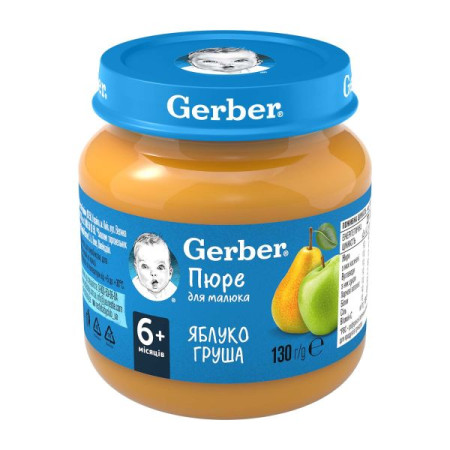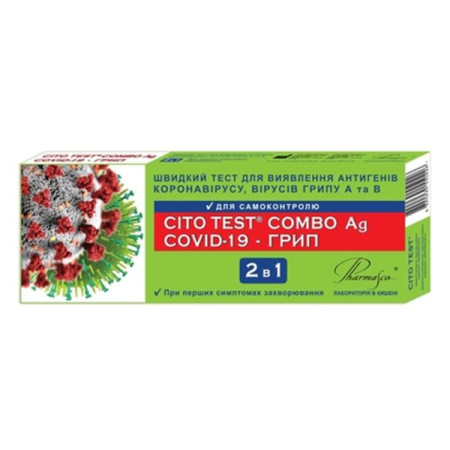Ephmerin powder for solution for injection 2 g bottle No. 1
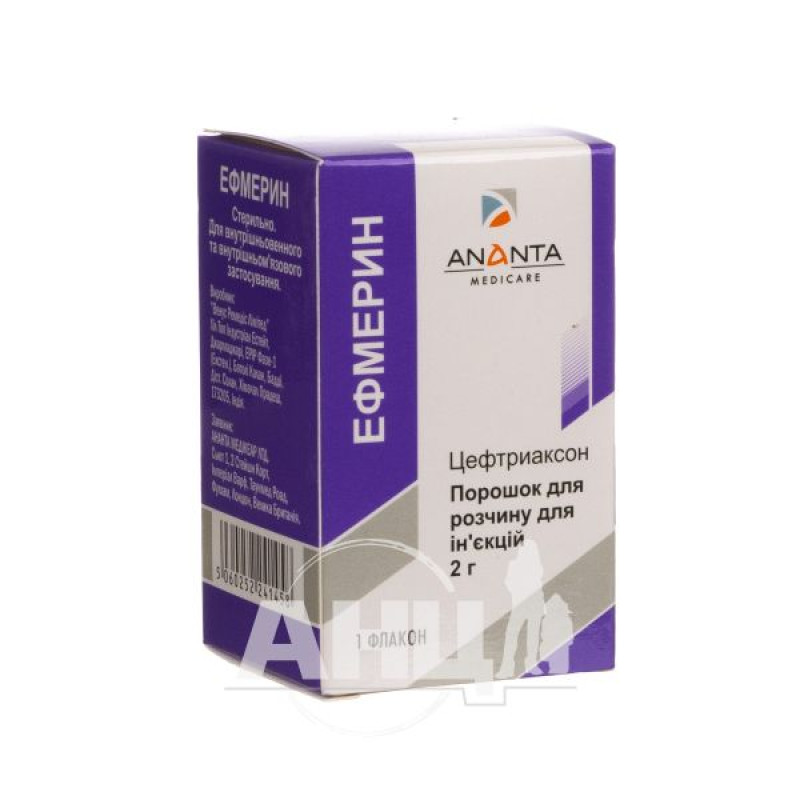
Instructions Ephmerin powder for solution for injection 2 g bottle No. 1
Composition
active ingredient: ceftriaxone;
1 vial contains ceftriaxone sodium equivalent to ceftriaxone 1 g or 2 g.
Dosage form
Powder for solution for injection.
Main physicochemical properties: white to yellowish crystalline powder.
Pharmacotherapeutic group
Antibacterials for systemic use. Other beta-lactam antibiotics. Third generation cephalosporins. Ceftriaxone. ATX code J01D D04.
Pharmacological properties
Pharmacodynamics.
Mechanism of action
Ceftriaxone inhibits bacterial cell wall synthesis after binding to penicillin-binding proteins. As a result, cell wall (peptidoglycan) biosynthesis is stopped, which in turn leads to bacterial cell lysis and death.
Resistance
Bacterial resistance to ceftriaxone may develop as a result of one or more of the following mechanisms:
hydrolysis by beta-lactamases, including extended-spectrum beta-lactamases, carbapenemases and Amp C enzymes, which can be induced or persistently inhibited in some aerobic Gram-negative bacteria;
reduced affinity of penicillin-binding proteins for ceftriaxone;
impermeability of the outer membrane in gram-negative bacteria;
bacterial efflux pump.
Limit values for determining sensitivity
Breakpoints for minimum inhibitory concentration determined by the European Committee on Antimicrobial Susceptibility Testing (EUCAST)
| Pathogen | Dilution method (minimum inhibitory concentration, mg/L) | |
| Sensitive | Resistant | |
| Enterobacteriaceae | ≤ 1 | > 2 |
| Staphylococcus spp. | a. | a. |
| Streptococcus spp. (groups A, B, C and G) | b. | b. |
| Streptococcus pneumoniae | ≤ 0.5c. | > 2 |
| Streptococci of the Viridans group | ≤ 0.5 | > 0.5 |
| Haemophilus influenzae | ≤ 0.12c. | > 0.12 |
| Moraxella catarrhalis | ≤ 1 | > 2 |
| Neisseria gonorrhoeae | ≤ 0.12 | > 0.12 |
| Neisseria meningitidis | ≤ 0.12c. | > 0.12 |
| Not related to the species | ≤ 1d. | > 2 |
a. Susceptibility is inferred based on susceptibility to cefoxitin;
b. Susceptibility is inferred from penicillin susceptibility;
c. isolates with minimum inhibitory concentrations exceeding the susceptibility breakpoints rarely occur. If this is observed, retesting should be performed and, if confirmed, sent to a reference laboratory;
d. The cut-off values relate to a daily intravenous dose of 1 g × 1 and a high dose of at least 2 g × 1
Clinical efficacy against specific pathogens
The prevalence of resistance of individual species may vary geographically and over time. It is advisable to obtain local information on the resistance patterns of microorganisms, particularly when treating severe infections. As necessary, specialist advice should be sought when the local prevalence of resistance is such that the benefit of the agent, at least in some types of infections, is questionable.
Generally sensitive species
Gram-positive aerobes
Staphylococcus aureus (methicillin-susceptible)1, coagulase-negative staphylococci (methicillin-susceptible)1, Streptococcus pyogenes (group A), Streptococcus agalactiae (group B), Streptococcus pneumoniae, Viridans group Streptococci.
Gram-negative aerobes
Borrelia burgdorferi, Haemophilus influenzae, Haemophilus parainfluenzae, Moraxella catarrhalis, Neisseria gonorrhoeae, Neisseria meningitidis, Proteus mirabilis, Providentia spp., Treponema pallidum.
Species for which acquired resistance may be a problem
Gram-positive aerobes
Staphylococcus epidermidis2, Staphylococcus haemolyticus2, Staphylococcus hominis2.
Gram-negative aerobes
Citrobacter freundii, Enterobacter aerogenes, Enterobacter cloacae, Escherichia coli3, Klebsiella pneumoniae3, Klebsiella oxytoca3, Morganella morganii, Proteus vulgaris, Serratia marcescens.
Anaerobes
Bacteroides spp., Fusobacterium spp., Peptostreptococcus spp., Clostridium perfringens.
Innately resistant microorganisms
Gram-positive aerobes
Enterococcus spp., Listeria monocytogenes.
Gram-negative aerobes
Acinetobacter baumannii, Pseudomonas aeruginosa, Stenotrophomonas maltophilia.
Anaerobes
Clostridium difficile.
Others
Chlamydia spp., Chlamydophila spp., Mycoplasma spp., Legionella spp., Ureaplasma urealyticum
1 All methicillin-resistant staphylococci are resistant to ceftriaxone.
2 Resistance rate >50% in at least one region.
3 Strains producing extended-spectrum beta-lactamase are always resistant.
Pharmacokinetics.
Absorption
Intramuscular injection
After intramuscular injection, the mean peak plasma level of ceftriaxone is approximately half that observed after an equivalent intravenous dose. The maximum plasma concentration after a single intramuscular injection of 1 g of the drug is 81 mg/l and is reached 2-3 hours after administration. The area under the plasma concentration-time curve after intramuscular injection is equal to that after an equivalent intravenous dose.
Intravenous administration
After intravenous bolus administration of ceftriaxone at a dose of 500 mg and 1 g, the mean peak plasma levels of ceftriaxone are approximately 120 and 200 mg/l, respectively. After intravenous infusions of ceftriaxone at a dose of 500 mg, 1 g and 2 g, the plasma levels of ceftriaxone are approximately 80, 150 and 250 mg/l, respectively.
The volume of distribution of ceftriaxone is 7–12 L. Concentrations well in excess of the minimum inhibitory concentrations for most important pathogens are found in tissues including the lungs, heart, biliary tract, liver, tonsils, middle ear and nasal mucosa, bone, as well as cerebrospinal, pleural and synovial fluids, and prostatic secretion. An 8–15% increase in mean peak plasma concentrations (Cmax) was observed with repeated administration; steady state was reached in most cases within 48–72 hours, depending on the route of administration.
Penetration into individual tissues
Ceftriaxone penetrates the meninges. Penetration is more pronounced in cases of inflammation of the meninges. The average peak concentration of ceftriaxone in the cerebrospinal fluid of patients with bacterial meningitis is up to 25% of that in blood plasma compared to
2% in patients without meningitis. Peak ceftriaxone concentrations in the cerebrospinal fluid are reached approximately 4–6 hours after intravenous injection. Ceftriaxone crosses the placental barrier and is expected to be present in low concentrations in breast milk (see section “Use during pregnancy and lactation”).
Binding to blood proteins
Ceftriaxone is reversibly bound to albumin. Plasma protein binding is approximately 95% at plasma concentrations below 100 mg/L. Binding is saturable and the extent of binding decreases with increasing concentration (to 85% at plasma concentrations of 300 mg/L).
Metabolism
Ceftriaxone is not subject to systemic metabolism, but is converted into inactive metabolites by the intestinal flora.
Breeding
The total plasma clearance of ceftriaxone (bound and unbound) is 10–22 ml/min. Renal clearance is 5–12 ml/min. 50–60% of ceftriaxone is excreted unchanged by the kidneys, primarily by glomerular filtration, 40–50% is excreted unchanged in the bile. The elimination half-life of ceftriaxone in adults is about 8 hours.
Patients with renal or hepatic insufficiency
In patients with impaired renal and hepatic function, the pharmacokinetics of ceftriaxone are slightly altered, with only a slight increase in the half-life (less than 2-fold), even in patients with severe renal impairment.
The relatively moderate increase in half-life in renal impairment is due to a compensatory increase in extrarenal clearance resulting from reduced protein binding and a corresponding increase in extrarenal clearance of total ceftriaxone.
In patients with hepatic impairment, the elimination half-life of ceftriaxone is not increased due to a compensatory increase in renal clearance. This is also due to an increase in the free fraction of ceftriaxone in plasma, which contributes to an apparent paradoxical increase in total clearance of the drug with an increase in the volume of distribution parallel to this total clearance.
Elderly patients
In patients aged 75 years and older, the mean half-life is usually 2–3 times higher than in younger adults.
Children
The half-life of ceftriaxone is prolonged in neonates up to 14 days of age. Free ceftriaxone levels may continue to increase as a result of factors such as decreased glomerular filtration and impaired protein binding. In children, the half-life is shorter than in neonates or adults.
Plasma clearance and volume of distribution of total ceftriaxone are higher in neonates, infants and children than in adults.
Linearity/nonlinearity
The pharmacokinetics of ceftriaxone are non-linear. All major pharmacokinetic parameters based on total drug concentrations, with the exception of half-life, are dose-dependent. Non-linearity is a result of saturation of plasma protein binding and is therefore observed in plasma for total ceftriaxone but not for free (unbound) ceftriaxone.
Pharmacokinetic/pharmacodynamic relationship
As with other beta-lactams, the pharmacokinetic/pharmacodynamic index that best correlates with in vivo efficacy is the percentage of the dosing interval over which the unbound concentration remains above the minimum inhibitory concentration of ceftriaxone for the individual target species (i.e. %T ˃ minimum inhibitory concentration).
Indication
Ceftriaxone is used to treat the following infections in adults and children, including full-term newborns (from birth):
bacterial meningitis;
community-acquired pneumonia;
hospital-acquired pneumonia;
acute otitis media;
intra-abdominal infections;
complicated urinary tract infections (including pyelonephritis);
bone and joint infections;
complicated skin and soft tissue infections;
gonorrhea;
syphilis;
bacterial endocarditis.
Ephmerine can be used for:
treatment of acute complications of chronic obstructive pulmonary disease in adults;
treatment of disseminated Lyme borreliosis (early (stage II) and late (stage III)) in adults and children, including newborns from 15 days of age;
management of neutropenic patients who have developed fever with suspected bacterial infection;
treatment of patients with bacteremia due to any of the above infections, or if any of the above infections is suspected.
Ephmerine should be prescribed together with other antibacterial drugs if the possible range of bacterial pathogens does not fall within its spectrum of action (see section "Special instructions for use").
Official recommendations on the appropriate use of antibacterial agents should be taken into account.
Contraindication
Hypersensitivity to ceftriaxone or to any other cephalosporin or to any of the excipients. History of severe hypersensitivity reactions (e.g. anaphylactic reactions) to any other type of beta-lactam antibacterial agent (penicillins, monobactams and carbapenems).
Ceftriaxone is contraindicated:
premature newborns aged ≤ 41 weeks, taking into account the term of intrauterine development (gestational age + age after birth)*;
full-term newborns (age ≤ 28 days):
with hyperbilirubinemia, jaundice, hypoalbuminemia, or acidosis, as bilirubin binding is likely to be impaired in these conditions*;
who require (or are expected to require) intravenous calcium preparations or infusions of calcium-containing solutions, as there is a risk of precipitation of the calcium salt of ceftriaxone (see sections "Special instructions", "Adverse reactions" and "Incompatibilities").
* In vitro studies have shown that ceftriaxone can displace bilirubin from its association with serum albumin, leading to a risk of bilirubin encephalopathy in such patients.
Before intramuscular administration of ceftriaxone, it is necessary to exclude the presence of contraindications to the use of lidocaine, if it is used as a solvent (see section "Special instructions for use"), see the instructions for medical use of lidocaine, especially the section "Contraindications".
Ceftriaxone solutions containing lidocaine should never be administered intravenously.
Interaction with other medicinal products and other types of interactions
Diluents containing calcium, such as Ringer's solution or Hartmann's solution, should not be used to reconstitute Ephmeron in vials or to further dilute the reconstituted solution for intravenous administration, as a precipitate may form. Precipitates of the calcium salt of ceftriaxone may also form when ceftriaxone is mixed with calcium-containing solutions in the same infusion system. Ceftriaxone should not be administered simultaneously with calcium-containing intravenous solutions, including calcium-containing solutions for long-term infusion, such as parenteral nutrition solutions, using a Y-line. However, in patients other than neonates, ceftriaxone and calcium-containing solutions may be administered sequentially, one after the other, provided that the system is thoroughly flushed with a compatible fluid between infusions. In vitro studies using adult and neonatal cord blood plasma have shown that neonates are at increased risk of precipitation of ceftriaxone calcium salt (see sections “Method of administration and dosage”, “Contraindications”, “Special precautions for use”, “Adverse reactions”, “Incompatibility”).
Concomitant use of the drug with oral anticoagulants may enhance the effect of the vitamin K antagonist and the risk of bleeding. It is recommended to frequently check the international normalized ratio (INR) and adjust the dose of the vitamin K antagonist appropriately both during and after ceftriaxone therapy (see section "Adverse reactions").
There is conflicting evidence regarding the potential for increased renal toxicity of aminoglycosides when used with cephalosporins. In such cases, the recommendations for monitoring aminoglycoside levels (and renal function) in clinical practice should be carefully followed.
In an in vitro study, antagonism was observed when chloramphenicol was used in combination with ceftriaxone. The clinical significance of this finding is unknown.
There have been no reported cases of interaction between ceftriaxone and oral calcium-containing drugs or between intramuscular ceftriaxone and calcium-containing drugs (intravenous or oral).
False-positive Coombs test results are possible in patients taking ceftriaxone.
Ceftriaxone, like other antibiotics, may cause false-positive test results for galactosemia.
Similarly, non-enzymatic methods for measuring urine glucose may give false positive results. For this reason, enzymatic methods should be used during ceftriaxone therapy.
No renal dysfunction has been observed after concomitant use of high doses of ceftriaxone and potent diuretics (e.g. furosemide).
Concomitant use of probenecid does not reduce the excretion of ceftriaxone.
Application features
As with all beta-lactam antibiotics, serious hypersensitivity reactions, sometimes fatal, have been reported (see section 4.8). Hypersensitivity reactions may also progress to Kounis syndrome, a serious allergic reaction that may lead to myocardial infarction (see section 4.8). In the event of a severe hypersensitivity reaction, ceftriaxone should be discontinued immediately and appropriate emergency measures should be taken. Before initiating treatment, it should be established whether the patient has a history of severe hypersensitivity reactions to ceftriaxone, other cephalosporins or other types of beta-lactam agents. Ceftriaxone should be used with caution in patients with a history of non-severe hypersensitivity to other beta-lactam agents.
Severe skin reactions (Stevens-Johnson syndrome or Lyell's syndrome/toxic epidermal necrolysis and drug reaction with eosinophilia and systemic symptoms (DRESS)), which can be life-threatening or fatal, have been reported with ceftriaxone; however, the frequency of these events is unknown (see section 4.8).
Interaction with drugs containing calcium.
Cases of ceftriaxone calcium precipitates in the lungs and kidneys, which were fatal, have been reported in premature and full-term infants up to 1 month of age. In at least one of these patients, ceftriaxone and calcium were administered at different times and through different intravenous infusion systems. According to the available scientific data, there are no confirmed cases of intravascular precipitates, except in neonates who were administered ceftriaxone and calcium-containing solutions or any other calcium-containing drugs. In vitro studies have shown that neonates are at increased risk of ceftriaxone calcium precipitates compared to patients of other age groups.
When ceftriaxone is used in patients of any age, it should not be mixed or administered simultaneously with any intravenous solutions containing calcium, even if different infusion systems are used or the drugs are administered at different infusion sites. However, in patients 28 days of age and older, ceftriaxone and calcium-containing solutions may be administered sequentially, one after the other, provided that the drugs are administered through different infusion systems at different body sites or that the infusion system is replaced or thoroughly flushed with saline between administrations to prevent the formation of a precipitate. For patients who require continuous infusions of calcium-containing solutions for total parenteral nutrition (TPN), healthcare professionals may prescribe alternative antibacterial agents that do not carry a similar risk of precipitate formation. If the use of ceftriaxone in patients requiring continuous parenteral nutrition is deemed necessary, PPH solutions and ceftriaxone may be administered simultaneously, albeit through different infusion systems and into different body sites. Alternatively, the PPH solutions may be withheld during the ceftriaxone infusion and the infusion systems flushed between administrations (see sections 4.3, 4.8, 4.8, and 4.9).
Children.
The safety and efficacy of ceftriaxone in neonates, infants and children have been established at the doses described in the section "Method of administration and dosage" (see section "Method of administration and dosage"). Studies have shown that ceftriaxone, like some other cephalosporins, can displace bilirubin from its association with serum albumin.
Ephmerine is contraindicated in premature and full-term newborns at risk of developing bilirubin encephalopathy (see section "Contraindications").
Immune-mediated hemolytic anemia.
Cases of immune-mediated haemolytic anaemia have been reported in patients receiving cephalosporin antibacterial agents, including ceftriaxone (see section 4.8). Severe cases of haemolytic anaemia, including fatalities, have been reported during treatment with ceftriaxone in both adults and children.
If a patient develops anemia while taking ceftriaxone, the diagnosis of cephalosporin-associated anemia should be considered and ceftriaxone should be discontinued until the etiology is determined.
Long-term treatment.
During long-term treatment, a complete blood count should be performed regularly.
Colitis/overgrowth of non-susceptible microorganisms.
As with the use of other antibacterial agents, superinfections caused by microorganisms insensitive to the drug may occur.
Severe renal and hepatic insufficiency.
In case of severe renal and hepatic insufficiency, careful clinical monitoring of the safety and efficacy of the drug is recommended (see section "Method of administration and dosage").
Impact on serological test results.
The use of the drug may cause false-positive results in the Coombs test. Ceftriaxone may also cause false-positive results in the test for galactosemia (see section "Adverse reactions").
False-positive results may be obtained when determining glucose in urine by non-enzymatic methods. During the use of the drug, glucose levels in urine should be determined by enzymatic methods of analysis (see section "Adverse reactions").
Ceftriaxone may cause falsely low blood glucose readings obtained with certain glucose monitoring systems. The instructions for use for each individual system should be consulted. Alternative testing methods should be used if necessary.
Sodium.
This medicinal product contains 3.6 mmol sodium. Caution should be exercised when administered to patients on a controlled sodium diet.
Spectrum of antibacterial activity.
Ceftriaxone has a limited spectrum of antibacterial activity and may not be suitable for use as monotherapy in the treatment of certain types of infection unless the causative agent is already established (see section 4.2). In polymicrobial infections where ceftriaxone-resistant organisms are suspected, additional antibiotics should be considered.
Use of lidocaine.
If lidocaine solution is used as a diluent, ceftriaxone can only be administered intramuscularly. Before administering the drug, it is necessary to take into account the contraindications to the use of lidocaine, precautions and other relevant information given in the instructions for medical use of lidocaine (see section "Contraindications"). Lidocaine solution should never be administered intravenously.
Gallstone disease.
In case of shadows on the sonogram, the possibility of ceftriaxone calcium precipitates should be considered. Shadows mistaken for gallstones have been observed on sonograms of the gallbladder, and their frequency increased with ceftriaxone doses of 1 g/day and above. Particular caution should be exercised when using the drug in children. Such precipitates disappear after discontinuation of ceftriaxone therapy. In rare cases, the formation of ceftriaxone calcium precipitates has been accompanied by symptoms. In the presence of symptoms, conservative non-surgical treatment is recommended and the physician should decide to discontinue the drug, taking into account the results of the benefit-risk assessment of the specific case (see section "Adverse reactions").
Bile stasis.
Cases of pancreatitis, possibly secondary to biliary obstruction, have been reported in patients receiving ceftriaxone (see section 4.8). Most of these patients had risk factors for cholestasis and biliary sludge formation, such as previous significant therapy, severe illness and total parenteral nutrition. It cannot be excluded that the formation of biliary precipitates due to the drug may be a precipitating or additional factor in the development of this disorder.
Kidney stone disease.
Cases of kidney stones have been reported, which resolved after discontinuation of ceftriaxone (see section 4.8). If symptoms are present, an ultrasound examination should be performed. The decision to use the drug in patients with a history of kidney stones or hypercalciuria should be made by the physician, taking into account the results of a benefit-risk assessment in the individual case.
Jarisch-Herxheimer reaction (JHR).
Some patients with spirochetal infections may develop a Jarisch-Herxheimer reaction (JHR) at the start of ceftriaxone therapy. JHR is usually self-limiting, or symptomatic treatment may be indicated. Antibiotic therapy should not be discontinued if this reaction occurs.
Encephalopathy.
Encephalopathy has been reported with ceftriaxone (see section 4.8), particularly in elderly patients with severe renal impairment (see section 4.2) or central nervous system disorders. If ceftriaxone-related encephalopathy is suspected (e.g., decreased level of consciousness, altered mental status, myoclonus, convulsions), discontinuation of ceftriaxone should be considered.
Disposal of unused and expired medication.
The release of the medicinal product into the environment should be minimised. The medicinal product should not be disposed of via wastewater or household waste. For disposal, a so-called waste collection system should be used, if available.
Use during pregnancy or breastfeeding
Ceftriaxone crosses the placental barrier. There are limited data from the use of ceftriaxone in pregnant women. Animal studies do not indicate direct or indirect harmful effects with respect to embryonal/fetal, perinatal or postnatal development. Ceftriaxone should be used during pregnancy, particularly during the first trimester, only if the benefit outweighs the risk.
Breast-feeding.
Ceftriaxone is excreted in breast milk in low concentrations, but no effects on breast-fed infants are expected at therapeutic doses. However, a risk of diarrhoea and fungal infections of the mucous membranes cannot be excluded. The possibility of sensitization should be considered. A decision should be made whether to discontinue breast-feeding or to discontinue/abstain from ceftriaxone therapy taking into account the benefit of breast-feeding for the child and the benefit of therapy for the woman.
Fertility.
Reproductive studies have shown no evidence of adverse effects on male or female fertility.
Ability to influence reaction speed when driving vehicles or other mechanisms
During treatment with ceftriaxone, side effects such as dizziness may occur, which may affect the ability to drive or operate machinery (see section "Adverse reactions"). Patients should be careful when driving or operating other machinery.
Method of administration and doses
Dosage
The dose of the drug depends on the severity, sensitivity, location and type of infection, as well as the patient's age and liver and kidney function.
The following doses are generally recommended for these indications. In particularly severe cases, the highest dose in the recommended range should be used.
Adults and children aged 12 years and over (≥ 50 kg)
| Ceftriaxone dose* | Frequency of administration** | Indication |
| 1–2 g | Once a day | Community-acquired pneumonia. Acute complication of chronic obstructive pulmonary disease. Intra-abdominal infections. Complicated urinary tract infections (including pyelonephritis). |
| 2 g | Once a day | Hospital-acquired pneumonia. Complicated skin and soft tissue infections. Bone and joint infections. |
| 2–4 g | Once a day | Management of neutropenic patients who develop fever and are suspected of having a bacterial infection. Bacterial endocarditis. Bacterial meningitis. |
* In case of documented bacteremia, the highest dose in the recommended range should be considered.
** In case of doses exceeding 2 g per day, twice daily administration (12 hours apart) should be considered.
Indications in adults and children aged 12 years and over (≥ 50 kg) requiring special dosing regimens
Acute otitis media
A single intramuscular dose of 1–2 g of Ephmerine may be used.
Some evidence suggests that in cases where the patient's condition is severe or previous therapy has failed, ceftriaxone may be effective when administered intramuscularly at a dose of
1–2 g per day for 3 days.
Preoperative prophylaxis of surgical site infections
2 g once before surgery.
Gonorrhea
Single dose – 500 mg intramuscularly.
Syphilis
The generally recommended dose is 500 mg to 1 g once daily, increasing to 2 g once daily for neurosyphilis over 10 to 14 days. Dosage recommendations for syphilis, including neurosyphilis, are based on limited data. National or local recommendations should also be considered.
Disseminated Lyme borreliosis (early (stage II) and late (stage III))
2 g once daily for 14–21 days. The recommended duration of treatment varies and should be based on national or local recommendations.
Children
Newborns, infants and children aged 15 days to 12 years (< 50 kg)
Children weighing 50 kg or more should use the usual adult doses.
| Ceftriaxone dose* | Frequency of administration** | Indication |
| 50–80 mg/kg | Once a day | Intra-abdominal infections. Complicated urinary tract infections (including pyelonephritis). Community-acquired pneumonia. Hospital-acquired pneumonia. |
50–100 mg/kg (maximum 4 g) | Once a day | Complicated skin and soft tissue infections. Bone and joint infections. Management of neutropenic patients who develop fever and are suspected of having a bacterial infection. |
80–100 mg/kg (maximum 4 g) | Once a day | Bacterial meningitis. |
100 mg/kg (maximum 4 g) | Once a day | Bacterial endocarditis. |
* In case of documented bacteremia, the highest dose in the recommended range should be considered.
** In case of doses exceeding 2 g per day, twice daily administration (12 hours apart) should be considered.
Indications in newborns, infants and children aged 15 days to 12 years (<50 kg) requiring special dosing regimens.
A single intramuscular injection of 50 mg/kg may be used for the initial treatment of acute otitis media. Some evidence suggests that in cases where the child is severely ill or previous therapy has failed, ceftriaxone may be effective when administered intramuscularly at a dose of 50 mg/kg daily for 3 days.
Preoperative prevention of infections at the surgical site.
50–80 mg/kg once before surgery.
Syphilis
In general, the recommended dose is 75–100 mg/kg (maximum 4 g) once daily for 10–14 days. Dosage recommendations for syphilis, including neurosyphilis, are based on very limited data. National or local recommendations should also be taken into account.
Disseminated Lyme disease (early (stage II) and late (stage III))
50–80 mg/kg once daily for 14–21 days. The recommended duration of treatment varies and national or local recommendations should be taken into account.
Newborns up to 14 days old
Ephmerine is contraindicated for use in premature newborns ≤ 41 weeks of age, taking into account the duration of intrauterine development (gestational age + age after birth).
| Ceftriaxone dose* | Frequency of administration** | Indication |
| 20–50 mg/kg | Once a day | Intra-abdominal infections. Complicated skin and soft tissue infections. Complicated urinary tract infections (including pyelonephritis). Community-acquired pneumonia. Hospital-acquired pneumonia. Bone and joint infections. Management of neutropenic patients who develop fever and are suspected of having a bacterial infection. |
50 mg/kg | Once a day | Bacterial meningitis. Bacterial endocarditis. |
* In case of documented bacteremia, the highest dose in the recommended range should be considered.
The maximum daily dose of 50 mg/kg should not be exceeded.
Indications in newborns up to 14 days of age requiring special dosing regimens.
Acute otitis media
A single intramuscular injection of Ephmerine at a dose of 50 mg/kg may be used for the initial treatment of acute otitis media.
Preoperative prophylaxis of surgical site infections
20–50 mg/kg once before surgery.
Syphilis
The generally recommended dose is 50 mg/kg once daily for 10–14 days. Dosing recommendations for syphilis, including neurosyphilis, are based on very limited data. National or local recommendations should also be taken into account.
Duration of treatment
The duration of treatment depends on the course of the disease. Taking into account general recommendations for antibiotic therapy, ceftriaxone should be continued for 48–72 hours after the disappearance of fever or confirmation of eradication of the bacterial infection.
Elderly patients
Provided that renal and hepatic function are satisfactory, dose adjustment is not required for elderly patients.
Patients with hepatic insufficiency
Available data suggest that there is no need to adjust the dose in patients with mild or moderate hepatic impairment, unless renal function is impaired.
There are no data from studies in patients with severe hepatic impairment (see Pharmacokinetics).
Patients with renal insufficiency
There are no reviews for this product.
There are no reviews for this product, be the first to leave your review.
No questions about this product, be the first and ask your question.






